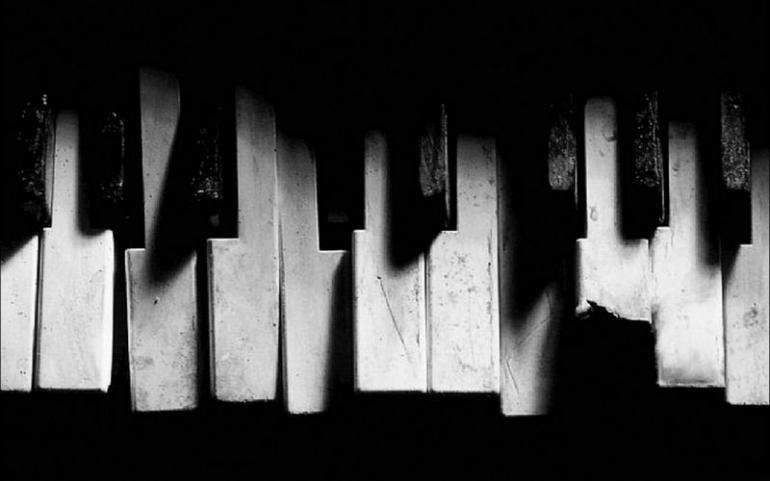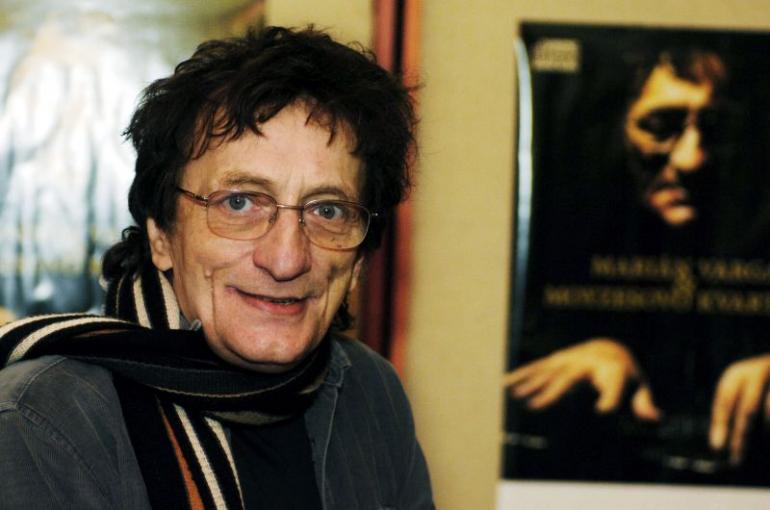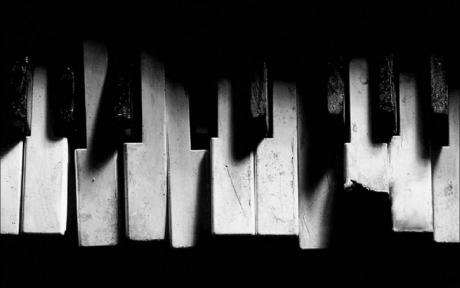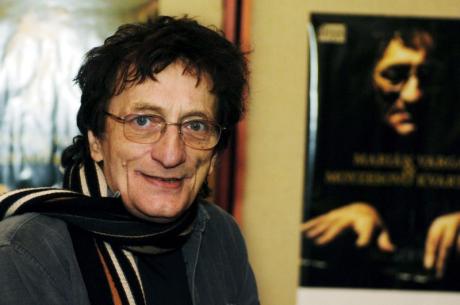Rockové klávesy - Piesne z kolovrátku a Eufónia

Part 1
Last month, we spoke about the first two sides of CM’s seminal album Konvergience. This month lets take a look at sides three and four. Piesne z Kolovrátku or The Spinning-Wheel Song begins with tight guitar chords accompanied Varga’s beautiful chords in interesting inversion that switch every so often from minor to major tonality. Some dominant chords contain the #9 scale degree strengthening the theme of an ambiguous third scale degree. The two players pass ideas back and forth with Varga constantly changing the sound of his organ; sometimes a little second percussion harmonic, then all of a sudden a very churchy oriented tibia setting. Out of nowhere, thunder and rain sounds appear and usher in a beautiful piano intro setting up the surprise vocals of Pavol Hammel. Varga’s touch on piano is subtle and convincing. One wouldn't guess an organist was playing. On the second verse, which quickly modulates to a new key, the drums of Dušan Hájek enter with dramatic effect. After the second statement of the melody, we get two interesting guitar solos from František Griglák. The first has a darker tone and is very short and melodic. As the chord progression moves through a few keys, a second, more over driven solo grabs us with a driving guitar accompaniment panned hard left. An organ and piano interlude over a pedal point bring us back to the recapitulation. At 6:00 we again fade to some unusual sound effects before a surprise drum solo from Hájek that exits as quickly as it appeared. It’s almost as if the piece is a theme and variations movement of a symphony. Each compact musical section references what came before. After the drum solo, we again switch gears quickly on the coda with several overlapping guitar tracks supported by shakers, hand percussion, and bass before small bells fade us into Part 2.

Part 2
Part 2 rocks harder that the cerebral first section with a driving bass line from Fedor Frešo. This section sounds a little like the rock band Yes at points, especially because of the brightness of the bass sound. Hammel’s new verse has a more urgent delivery bolstered by Varga’s percussive organ chords. On the chorus, the group goes into a complex 7/4 time signature as Hájek paves the way for Varga’s spitty organ with some incredible fills. At 3:16 we get an anthemic rock progression of four chords with an odd theremin like solo that twists and turns chaotically as the group rocks out. The section slowly fades as a sound somewhere between Celeste and organ takes over with a gentle dream-like lullaby. The subtle spinning speaker on the organ creates an otherworldly effect against the bells. It sounds as if Varga hits an unusual note as the section abruptly ends in an audible chuckle. Another guitar coda much like the end of the first movement is presented in a waltz this time before we get a second coda from Varga, this time on pipe organ. A gentle hymn with Hammel trades with dissonant all elbows on the keys, organ blasts. The heavily dissonant chord progressions continue to interrupt and contrast the beautiful hymn in shocking explosions. Varga approaches his pipe organ settings much like the Hammond; switching from one registration to another quickly to provide many different organ timbres.

Eufónia
Part 1
Part 1 begins with a dominant to tonic cadence that Varga joins on the off beats with plinky, percussive organ. The drums and guitar come in and grab the riff before a guitar solo in octaves. Another statement of the riff sets up a second Leslie speaker effected guitar solo and a jaunty melody that trades with what sounds like a timpani. The second section begins with a statement of the original melody, this time with crunchier chords that have some odd extensions. That’s when the fun starts! Splashy cymbals provide a welcoming canvas for wild electronics and detuned guitars that fade into nothing as we get some shockingly screechy distorted organ. The irony of the song title slowly becomes evident to the listener. Euphóny is defined as “the quality of being pleasing to the ear, especially through a harmonious combination of notes”. The listener is possibly being asked by Varga if they can adjust their perception to hear his wild dive-bombing organ as beautiful. The music on sides three and four of Konvergience is definitely more avant guard than the first half of the album and shows a darker, more mystical side of MC. A slow flange effect stars to cover the whole sonic landscape as tremoloed piano chords bring in Part 2.
Part 1
In the way part 1 has the most gorgeous organ tones decay into electronic hiss and atonality, part 2 deconstructs the piano. The music is now very minimal, floating in and out of ring modulated distortion like some kind of distant scary dream. Reverb and prepared piano strumming create a hovering din. Varga revisits earlier themes that are disguised by the delay washed atonal piano. Themes are always returning in a very sly way with MC. The music has already happened and you ask yourself, “Hey where did I hear that before?”. A short piano intro accompanies the return of the children’s choir from side one in this way. This time, the cherubs are framed inside a dark electronic din treated with a reverb that makes the once angelic choir sound sinister. Sample and hold influenced electronics percolate before fading into silence from which a slow growing white noise develops. The organ coda's steady quarter note pulse keeps growling as more organ stops are pulled out. MC has such patience on this last side. Every musical idea takes time to blossom and really sets an eerie mood creating a physical effect on the listener of this epic record.
Rock key glossary
Tight: Ve slovníku najdete překlad „těsný“ či „utažený“. V hudebním kontextu se ale toto přídavné jméno používá ve smyslu „konkrétní“, „čitelný“ či „vyrýsovaný“. Nejvíce to souvisí s basovou složkou zvuku. Pokud je basů příliš nebo jsou nekonkrétní, označíme zvuk za „loose“, v opačném případě „tight“ (basy jsou „přesné“, nehltí se).
Ambiguous: Nejednoznačný. Pokud takto označíme určitý tón, myslíme tím, že nám jeho použití neposkytuje dost informací o tom, o jaký akord se jedná (může patřit do mnoha různých stupnic).
Tibia setting: Mezi hráči na Hammondy se toto označení vžilo pro nastavení táhel 808808008.
Pedal point: Na tento termín jsme narazili už v minulosti, ale pro jistotu: jedná se o tón či jednoduchou figuru hranou basovým nástrojem. Tento motiv v basu zůstává neměnný (ostinato či prodleva), zatímco vyšší hlasy harmonii mění.
Switch gears: Tato fráze znamená „zařadit jinou rychlost“. V přeneseném významu ji však můžeme použít i v hudbě ve smyslu „prudce změnit“ (např. tempo, tóninu, metrum, náladu apod.).
Cerebral: Ve slovníku najdete překlad „mozkový“, znamená to ale také „promyšlený“, „sofistikovaný“, „intelektuálský“ apod.
Hymn vs anthem: Pozor, slovo „hymn“ je tzv. „false friend“, tedy výraz, který vyvolává klamný dojem, že má stejný význam jako podobné slovo v češtině. Nejedná se však o hymnu (tu překládáme slovem „anthem“, které se v článku také vyskytuje), ale o chvalozpěv, ódu či hymnus.
Plinky: Kovově zvonivý.
Spitty: odpudivý
Jaunty: Veselý, bezstarostný, bujarý.
Din: Slovo „din“ se používá pro označení hluku vytvářeného mnoha disharmonickými zvuky zároveň.
Cherubs: Cherubín nebo anděl, v tomto případě má však Brian na mysli členy dětského sboru.
Percolate: „Prosakovat“, což v hudebním kontextu znamená „vynořit se z pozadí“...
Eerie: Tajuplný, magický.






